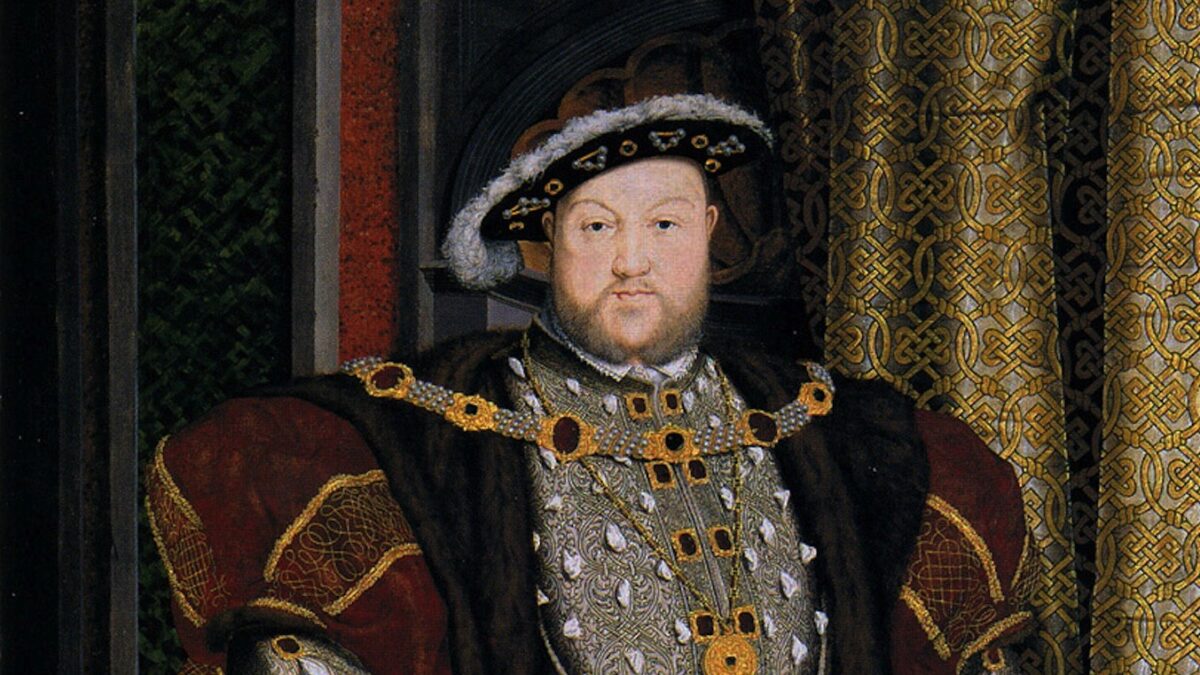While attending the recent opening of “Holbein: Capturing Character,” the new exhibition dedicated to the German Renaissance master Hans Holbein the Younger (c. 1497-1543) that just opened at the Morgan Library and Museum in New York, I observed a visitor asking the security guards, “Where are the pictures of Henry VIII and Thomas Cromwell?”
This was a fair question since Holbein, although born in Augsburg and for many years a citizen of Basel, is most famous for the portraits he executed in London, where he eventually became King’s Painter to Henry VIII (1491-1547). If you imagine Tudor England in your mind’s eye, chances are the way you envision its people stems directly from the work of this artist.
Striking up a conversation with the questioner, a man of somewhat Henrician proportions himself, I learned that he had driven all the way up from southern New Jersey that morning to see the show before having lunch with old school friends. He found it odd that not only were there no images of the Tudors in the exhibition, but Holbein’s famous 1527 portrait of St. Thomas More (1478-1535) was in the show, while his 1530s portrait of More’s rival Thomas Cromwell (c. 1485-1540) was not—yet both paintings reside at the Frick Collection, just some blocks away up Madison Avenue.
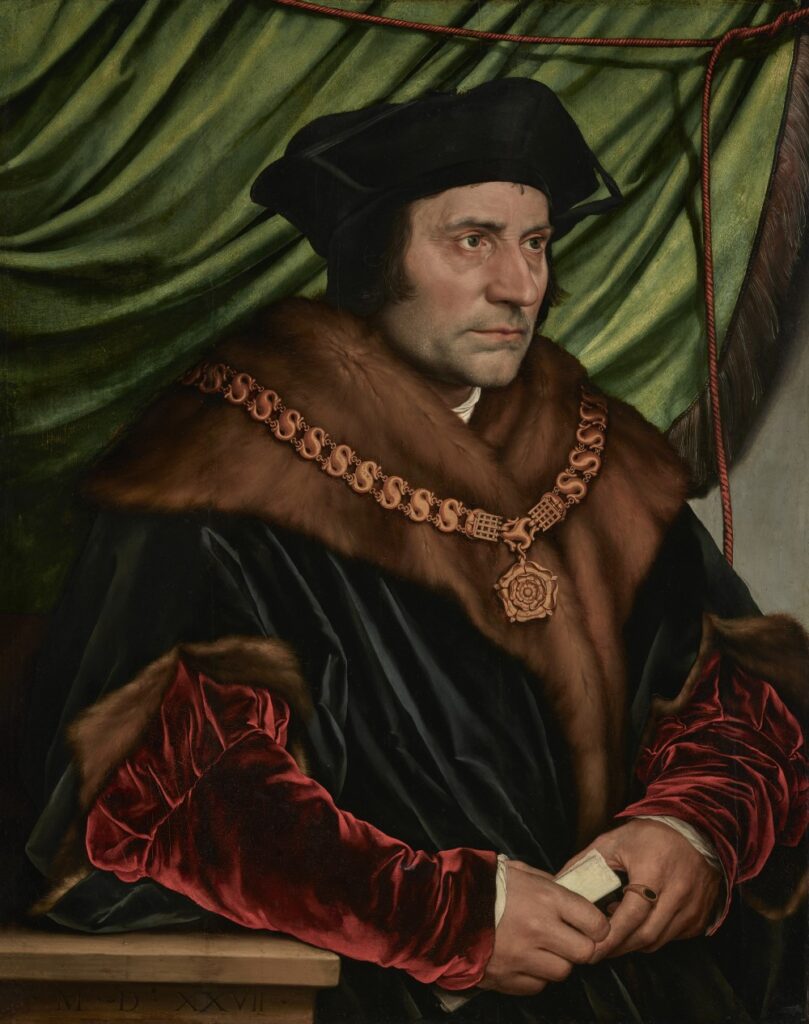
Sir Thomas More.
1527, Oil on panel. 29 1/2 x 23 3/4 in. (74.9 x 60.3 cm)
The Frick Collection, New York, 1912.1.77
Photo: Michael Bodycomb
While these were perfectly valid observations, this is not a show about creating artistic propaganda on behalf of a ruling family, as with the Medici portraits at the Met last year. Rather, this exhibition attempts to give the visitor a broad overview of the type of work Holbein created throughout his career.
To that end, the show’s organizers have put together the largest assemblage of Holbein’s work ever mounted in the United States. It’s clear from the catalog, however, that this isn’t fully the show the organizers had planned.
The Tudors We Don’t See
Given the rare, sometimes delicate state of surviving Holbeins, whose ability to travel is now further impinged by the vagaries of those still preoccupied with Covid, putting this show together outside of the United Kingdom or Europe was always going to be difficult. Simply too few pieces by Holbein reside in the United States.
For example, there are perhaps 100 drawings by Holbein left in existence, and the only one that resides in the United States is at the Getty Museum, where the show ran prior to coming to New York. Meanwhile, the queen owns around 80 Holbein drawings and generously lent several to the exhibition. As a result, the catalog is more than just an afterthought or a nice souvenir: it’s a kind of might-have-been-but-for. It’s also a useful way to get to know Holbein the artist, without getting overly distracted by the Tudors’ scandals.
The closest we get in the exhibition to a member of the Tudor dynasty, albeit by marriage, is a circa 1538-42 drawing of William Parr, marquess of Northampton (1513-1571), the younger brother of Henry VIII’s sixth and surviving wife, Catherine Parr (1512-1548). The marquess was known for being a snappy dresser, a fact borne out in Holbein’s drawing.
Parr sat for his session with Holbein in a jaunty, feathered hat covered with jewels, and a fur-lined, velvet and satin gown, a garment that in real life was purple and white striped. We know this because here, as in many of his portrait drawings, Holbein made notes to himself about the colors he would need to use in completing a subsequent painting of his subject.
For sheer, unabashed dandyism, the star of the entire show is unquestionably Holbein’s striking roundel portrait of Simon George of Cornwall, painted circa 1535-40. I was completely unfamiliar with this piece, partly because no one at present knows very much about the sitter, and the picture resides in the Städel Museum in Frankfurt, Germany, a city I’ve never visited.
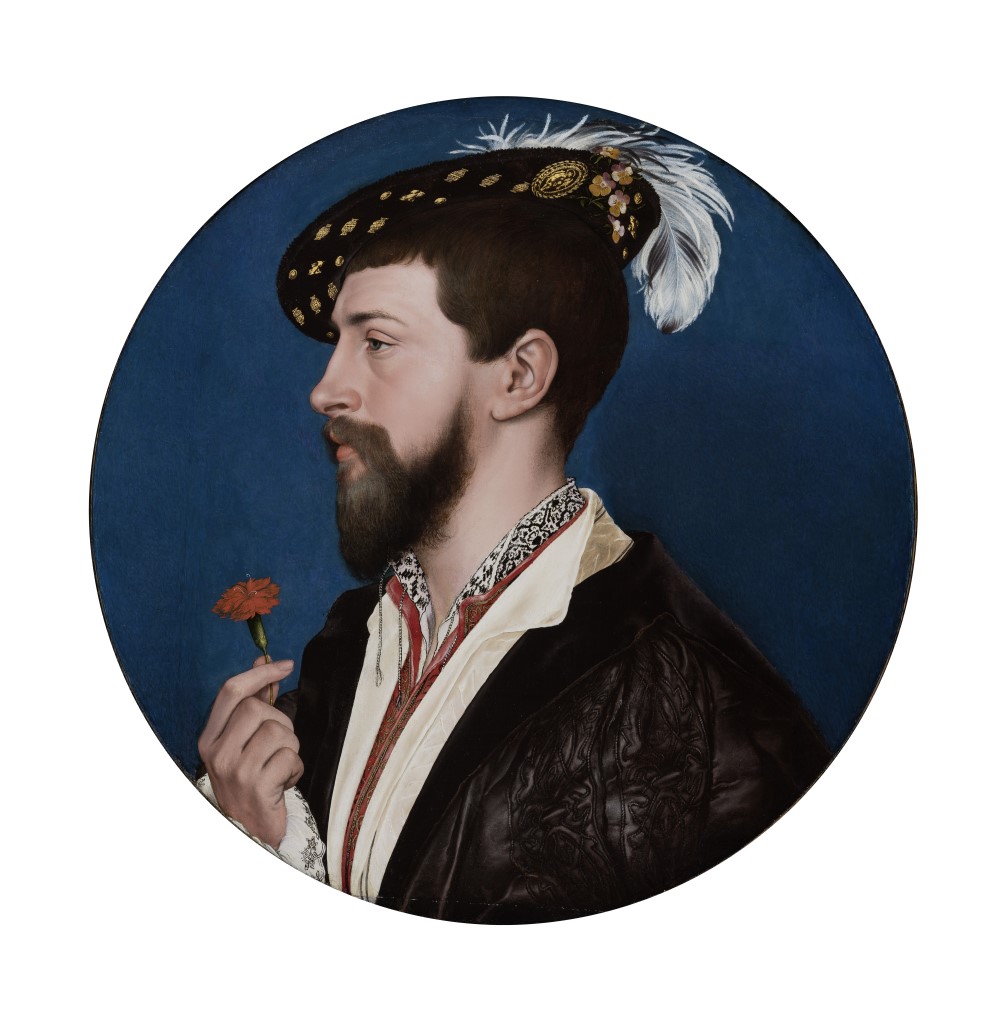
Simon George, ca. 1535 – 40.
Mixed technique on panel. 12 3/16 in. (31 cm)
Städel Museum, Frankfurt am Main, 1065. Photo: Städel Museum
Speculation says George may have been a poet, or the painting may have been executed as an engagement gift. Visitors to the show will be fortunate enough to see the change in Holbein’s subject between the drawing and painting phases, since by the time his portrait was painted, George had let his previously trim beard grow to full hipster length.
As in Holbein’s drawing of Parr, George sports a similarly rakish, feathered hat covered in gold and jewels. He wears a white undertunic with black vines embroidered around the collar, under a coral pink jerkin embroidered in gold. Over this, we see a cream-colored tunic with thin blue stripes along the seams, and over this, he wears what can best be described as a black leather puffer jacket.
It’s a bold, edgy look for someone who was neither royal nor, so far as we know, an aristocrat. If this was indeed a present to George’s future bride, we have to assume that she was just as fashion-forward as he was, in order to catch the eye of this peacock.
A Look into More Ordinary Lives
Not all of the men in the show were as flashy. Paintings depicting members of the German merchant community in London, for example, show serious, bearded men dressed in the kind of sober clothing that was expected of and indeed legislatively mandated of the mercantile class, who were not permitted to dress in finery in public.
Distinguished from one another primarily by their features and expressions, these weren’t the sorts of fellows to pick up a lute and sing love songs written by the king or make merry at a hunting party. Yet without them and others like them, London would never have become a center for world trade.
On the whole, the ladies of the exhibition do not fare as well as the men; indeed, some of them appear quite dour. The completed 1527 portrait of Mary, Lady Guildford from the St. Louis Art Museum showcases a great deal of Renaissance finery and symbolism.
Yet it’s just not as visually appealing as the original, more mischievously flirtatious image of Lady Guildford that Holbein drew of her from life, and which is now in the Kunstmuseum Basel. It’s a pity this drawing could not travel to New York for the exhibition, as contrasting two images of the same lady in the same attire side-by-side, but in different poses and moods, would have been a great opportunity.
That said, I was very pleased to see the image of one lady I’m familiar with who was able to come to New York from London, and who is usually referred to as “A Lady with a Squirrel and a Starling” (c. 1526-28). I haven’t seen this picture in person for many years.
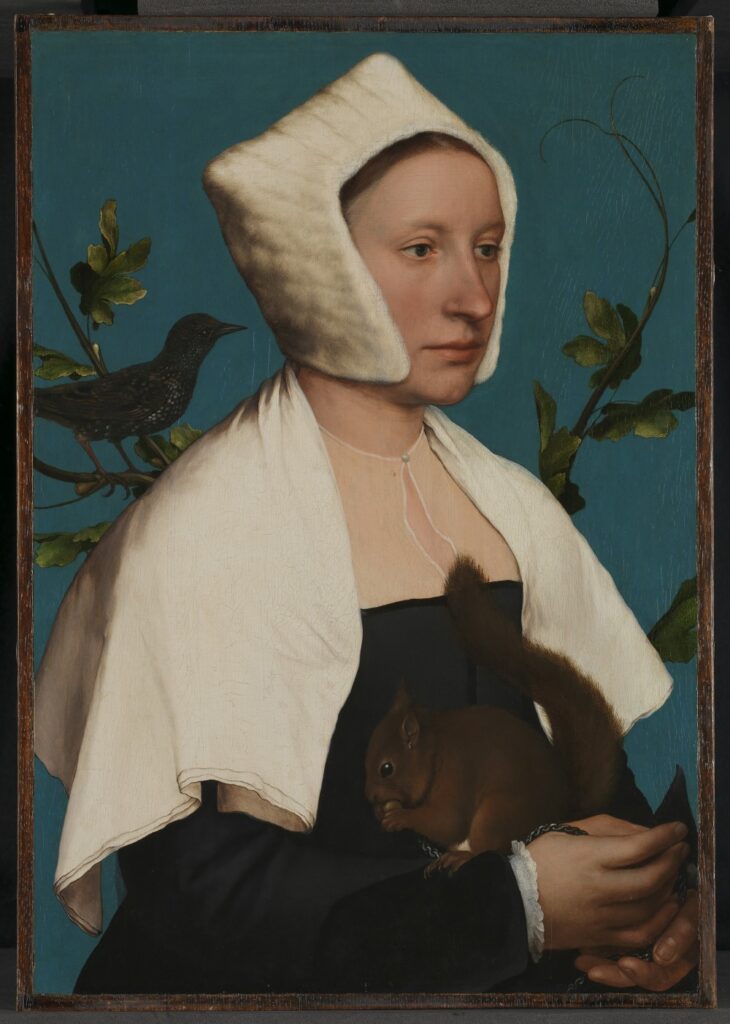
A Lady with a Squirrel and a Starling (Anne
Lovell?)
ca. 1526 – 28. Oil on panel
29 3/4 × 23 1/6 ×4 1/16 in. (75.5 × 58.5 10.3 cm)
National Gallery, London, NG6540
© The National Gallery, London.
As I suspect is the case for most viewers, I’ve always been charmed by the pet red squirrel the sitter holds in her lap. Both it and the starling are probably a reference to the sitter’s coat of arms and family seat, so that increasingly scholars are persuaded she may well be Lady Anne Lovell, whose husband Sir Francis Lovell was a close companion and quasi-bodyguard of Henry VIII.
On this viewing, I was struck for the first time by the wonderful detail Holbein works into his depiction of the lady’s cap, which appears to be made of warm, luxurious white fur. Notice how, with subtle variations in shading, Holbein captures the effect of the channeled stitching that runs from the front to the back of the hat. Holbein’s mastery of representing the tactile in two dimensions is such that you can easily imagine just what that would feel like if you were to run your fingers along those indentations—not while Anne was wearing it, of course.
Portraits and Jewels
Perhaps another exception should be made for the lovely circa 1535-40 portrait of an unidentified young woman, believed to be a member of the Cromwell family, lent by the Toledo Museum of Art. While the young lady is elegantly dressed and charmingly demure, the piece is particularly interesting in the context of the exhibition because it hangs next to a sheet of jewelry designed by Holbein.
One of these designs is for the large gold medallion on the front of the sitter’s gown. The jewel depicts the biblical story of an angel leading Lot and his family away from the destruction of Sodom and Gomorrah, and incorporates a rectangular gem in the center. This stone symbolizes Lot’s wife who, as described in Genesis 19:26, was turned into a pillar of salt. To decipher the symbolism of why one would want to wear such a bauble, you’ll have to do a bit of reading and thinking.
More importantly, as this juxtaposition of portrait and jewel in the exhibition demonstrates, Holbein was not only a master painter but also an extraordinarily gifted designer. From luxury items such as gold-encrusted hat badges and solid silver fountains to illuminated capital letters, book illustrations, to ephemeral party decorations, Holbein did not limit himself to working in only one or two creative genres.
Man’s Ultimate Fate
The show provides a wide selection of examples of artistic productions in which Holbein was involved, ranging from one-off precious objects commissioned by courtiers as gifts for the king, to mass-produced, woodcut prints illustrating the medieval fascination with death.
The section on the “Dance of Death” is unique to the Morgan version of the show, and sets a very different tone to the explorations of humanism, courtly life, and fashion that otherwise predominate in the exhibition. The artistic exploration of man’s ultimate fate, from an age when the acceptance of mortality was not intentionally absented from the public square as it is at present, may strike the contemporary viewer as macabre. Yet Holbein knew well how to make the most of widely disseminated, popular images on this subject, using the printing press.
From the early, so-called “Death Alphabet” printed after Holbein’s designs in 1523 to later woodblock prints from 1538 in which Holbein shows how death comes for everyone regardless of station, from pope to nun, duchess to plowman, Holbein never ran away from death artistically. With Europe in a near-constant state of war during the 16th century, the spread of poorly understood infectious diseases through urban environments, and Holbein having to work under the reign of a deranged megalomaniac, the possibility of an unexpected death was always around the corner, at all levels of society. In the end, death came all too early for Holbein himself, for he died in London at about the age of 45, probably of the plague.
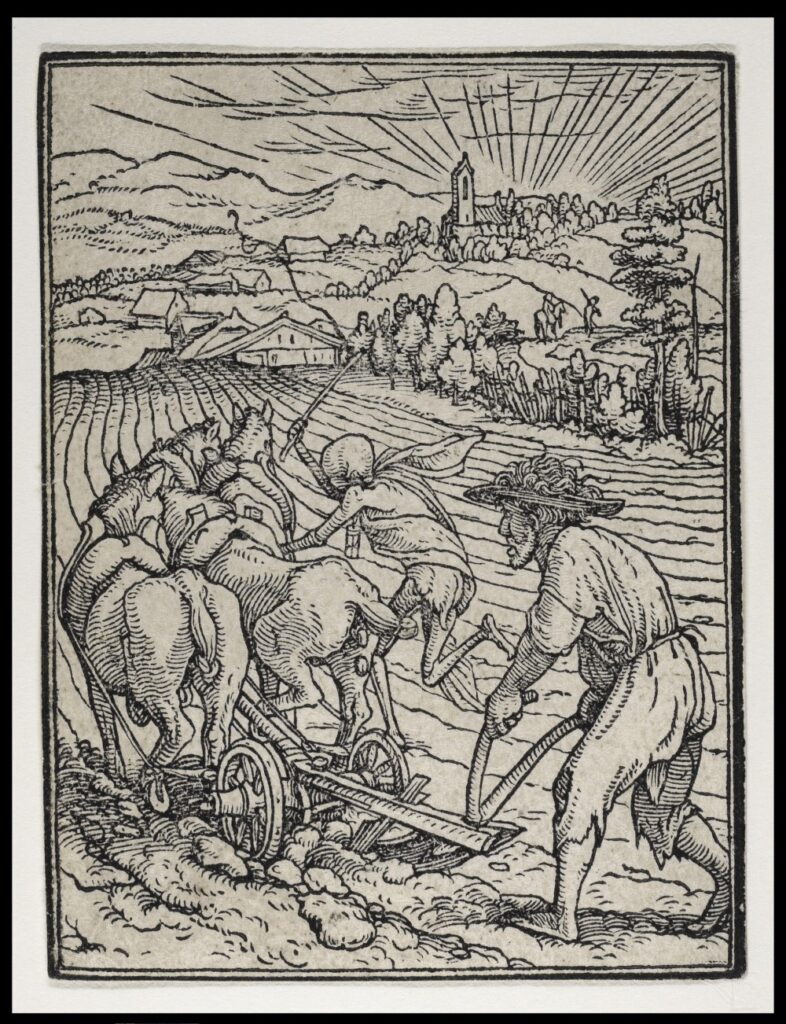
by Hans Holbein the Younger (1497/98 – 1543)
Death and the Plowman
ca. 1526. Woodcut. 2 9/16 x 1 15/16 in. (6.5 x 4.9 cm)
The Metropolitan Museum of Art, New York, 19.57.37
© The Metropolitan Museum of Art. Image source: Art Resource, NY
During the height of his career and fame in England, Holbein somehow managed to survive and thrive under the despotism of Henry VIII. Unlike More, Cromwell, and others who had also been his artistic patrons, Holbein continued to be in demand right up until he died.
While this first major American exhibition to examine the breadth of Holbein’s artistic output is not what it might have been had it been put on before 2020, it’s a long-overdue assessment on these shores of an artist whose inventiveness, observation, and technical skill not only defined how we all imagine the Tudor age, but whose work continues to delight and dazzle the eye.
“Holbein: Capturing Character” is at the Morgan Library and Museum in New York through May 15, 2022.
